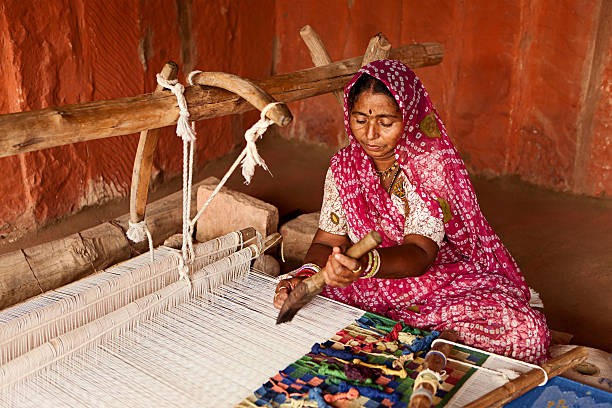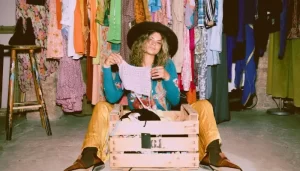Handmade clothing is an art full of history and creativity. It occupies a special place in the fashion world. In an age of mass production and fast fashion, custom clothing showcases the talent, dedication, and artistry of its maker. This article explores the social significance, enduring appeal, and rich history of handmade clothing. It also talks about the artists who made the clothes.
Historical Roots:
Handmade clothing originates from ancient societies, when clothes were carefully made by skilled artisans using age-old methods. In places like ancient China and the Mediterranean, clothing was not only a way to protect oneself from the weather, but also a sign of status, rank, and skill.
During the Industrial Revolution, machines took over the heavy work of spinning and weaving, a huge change in the textile industry. While this change made things more efficient and accessible, it also severed the manufacturer’s close relationship with the garments. But handmade clothing keeps coming back because artists keep old techniques and pass them on from generation to generation.
Cultural Significance:
Handmade clothing is closely linked to national identity and tradition. Clothing is available in many different styles, colors, and materials to suit every region. Intricate embroidery on Indian saris, bright beading on African textiles, and delicate lace on European fashion are all examples of handmade garments that showcase the diverse stories and customs of people around the world.
In many cultures, making clothes by hand is considered a sacred act, often associated with ritual, tradition, and symbolism. Clothes are no longer just clothes; they contain the history and spirit of society and represent pride in culture and continuity.
Slow Fashion Movement:
In recent years, the slow fashion trend has developed as an alternative to fast fashion. An important part of this trend is handmade clothing, which values quality over quantity, sustainability over disposable items, and craftsmanship over mass production. Slow fashion encourages people to think about what they buy and supports small businesses and fair trade.
Handmade clothing is of course good for the environment. Artists often use materials that can be found nearby, which reduces the carbon footprint of transportation. In addition, handmade clothes are easier to keep for a long time and not to throw away after a few tries, because they are durable and have a classic style.
Craftsmanship:
The skill of the craftsman, the care and attention to stitching details, and the personal investment in each piece make handmade clothing unique. Each garment is a unique work of art that shows the creativity and uniqueness of the person who made it. When clothing is made by hand, it adapts not only to the body but also to the wearer and his style.
Craftsmen, who often work from home or in small workshops, take pride in the work they do. Each garment is made slowly and carefully, allowing the maker to feel connected to the final product. The intimacy of this relationship is reflected in the end product, but also the energy and emotion of the creator.
Keep Traditional Methods Alive:
Handmade clothing preserves traditional skills that may be lost due to new technological innovations. Whether it is natural dyeing, hand weaving, or complex hand embroidery, the master will teach his students. This keeps the cultural and artistic heritage alive.
Maintaining traditional techniques is important for national identity and for preserving the diversity and richness of global crafts. Designers are coming up with new ways to use ancient techniques and modern styles, with handmade clothing connecting the past and the future.
Problems and Successes:
While the beauty and value of handmade clothing are undeniable, artists struggle in a world where mass production is the norm. Making each garment by hand can take a lot of time, making homemade clothing more expensive than factory-made clothing. The market’s focus on volume and speed has also made it harder for traditional crafts to survive.
Fortunately, hope is just around the corner. People are once again interested in handmade clothing as they become more aware of sustainable practices and ethical sourcing. With the help of the community and thoughtful buyers, artisans are figuring out how to solve these problems and ensure their craftsmanship survives and grows.
Conclusion
Handmade garments are timeless examples of people’s creativity and technical capabilities. The handmade garments are a reminder of the beauty that comes from acting more slowly and carefully, in a world that often values speed and quantity over skill and quality.
As people become more aware of the impact of their choices on the world and others, handmade clothing is becoming increasingly popular. Handmade clothing is more than just a fashion statement. They celebrate art, customs, and the power of the human spirit. Handmade clothing has great cultural significance and is carefully crafted to last. By purchasing handmade clothing, we help preserve rich cultural history, support skilled artisans, and embrace more sustainable and meaningful ways of dressing.
FAQs
1. How would you define homemade clothing?
When clothing is made by hand, it is made by skilled artists using old-fashioned methods. The garments show a traditional touch, attention to detail, and personal creativity.
2. What role does handmade clothing play in history?
Handmade clothing has a long history, dating back to ancient civilizations. It has changed over time and represents skills, culture, and social norms.
3. How does handmade clothing help people learn about their culture?
The unique styles, patterns, and materials of handmade clothing have deep ties to cultural history. This is an important way for people around the world to preserve and share their stories and customs.
4. What is “slow fashion”? How does handmade clothing fit into this?
Unlike fast fashion, the slow fashion movement promotes quality, sustainability, and ethical behavior. Handmade clothing fits in with the philosophy of slow fashion because it supports local artists and promotes timeless patterns.
5. How does handmade clothing help the environment?
Handmade clothing is better for the environment because local materials are used, reducing the carbon footprint created during transportation. Since handmade clothes last longer, they can also help you get more durable clothes.
6. How is homemade clothing different from mass-produced clothing?
Handmade clothing with an artisanal touch and attention to detail, each piece is custom and made just for you. It differs from popular fashion, which is characterized by uniformity and mass production.


